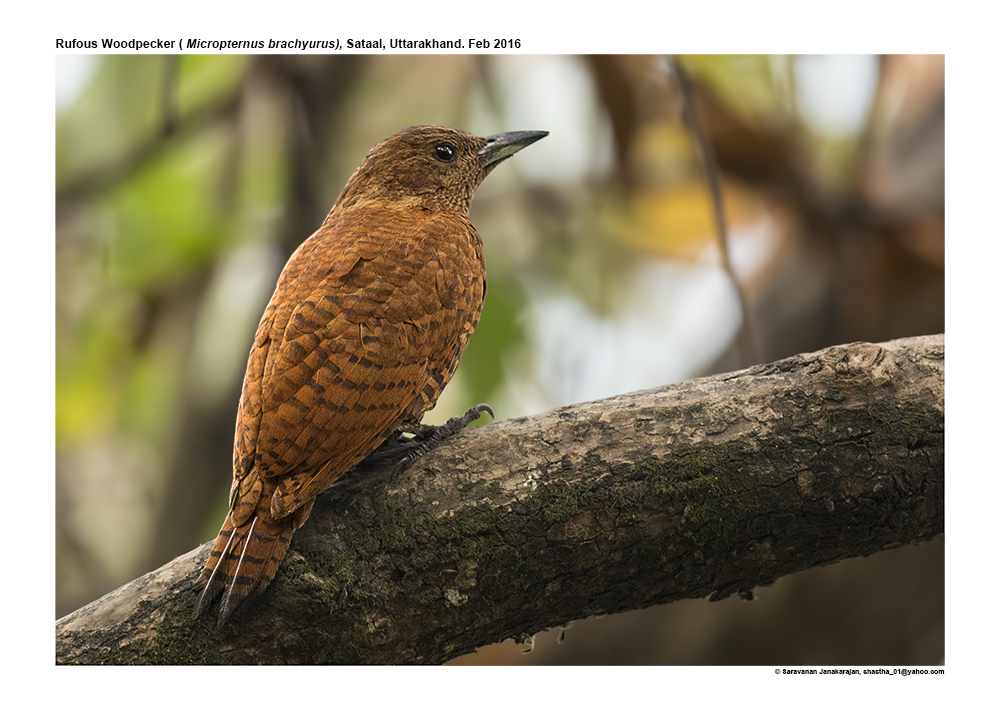Rufous Woodpecker

Rufous Woodpecker Micropternus brachyurus
Etymology:
- Micropternus : Greek word mikros- small; pterne – heel
- Brachyurus : Greek word brakhus short; –ouros -tailed
Vernacular Names: Hindi: Lal Kaathphora, Ben: Kath thokra, Cachar: Daoja gadaiya tunti, Guj: Keedighar lakkad khod, Mar: Tambus Sutar, Ta: Maramkotti, Thachchan kuruvi, Maram tolachhi, Mal: Chempan maramkotti, Sinh: Dumburu kerella
Distribution in India: Resident of Himalayas, East, West and North East in India.
Description: Size of 25 cm; wt. of 55–84 g. The male has dark brown forehead to nape and short crest, broad red feather tips beneath eye to front of ear-coverts, dark throat with buff feather tips. The rest of head and body plumage is dark rufous to chestnut, upperparts are very narrowly barred black, and flanks to undertail-coverts are with widely spaced thin black bars. The belly has thin broken bars, wings are similar to upperparts; tail is also narrowly dark-barred with broader black tips. The underwing is rufous and barred black. It has a short bill, culmen slightly curved, narrow-based, dark grey with blacker tip. The iris is reddish to brown, narrow orbital skin is grey and legs are blue-grey or bluish-green to brown. The female lacks red on side of head. The juvenile is like adult, variably barred, often less heavily, or sometimes with bars extending to breast.
Habitat: It is found in primary forest and secondary forest, both evergreen and deciduous, open forest, secondary growth, forest edge and scrub preferred. It is found from plains up to 1740 m..
Food habits: It eats ants and their brood, termites and vegetable matter eaten like fruits, nectar and sap. It stays in pairs; sometimes with mixed-species flocks. It forages at all levels, including high canopy of tall forest, and occasionally on ground. It perches crosswise on twigs. It searches vines, trunks, branches, twigs, bamboo; on ground, in small termite mounds or anthills, even in cow-pats; also explores rotting logs for food. The chief feeding techniques are gleaning and probing. It also pecks at insects nests from a perch close by; clings at nest, tears it apart, gleans ants that swarm out, also picking them from its plumage and feet. It also punctures banana stems to feed on the oozing sap. It is very active, almost constantly on the move, remains at a site only if abundant food source.
Breeding habits: They breed in Apr–Jun in Nepal, Sikkim and N Myanmar, Feb–Jun in South India and Sri Lanka, Jan–Apr in Thailand and Malaysia, May–Jun in Sumatra, and in Apr and Sept in Java. The displays include tail-spreading, head-swinging and body-swinging. The nest-hole is dug by both sexes and is often in active arboreal nest of ants .They lay a clutch of 2–3 eggs. Both the sexes incubate. The incubation period is 12–14 days. Both parents also feed chicks, by regurgitation.